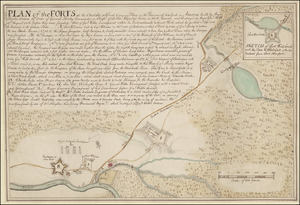The Course of the Wood Creek from the Mowhock River at the Onoida or Great Carrying Place to The Onoida Lake. Representing the Forts built on the Carrying Place by order of General Shirley: and Afterwards destroyed by Major General Webb
This map is also available in American Revolutionary Geographies Online (ARGO), a collections portal especially built for material relating to the American Revolutionary War Era. Visit ARGO to learn more about this item and explore the historical geography of North America in the late eighteenth century.
Item Information
- Title:
- The Course of the Wood Creek from the Mowhock River at the Onoida or Great Carrying Place to The Onoida Lake. Representing the Forts built on the Carrying Place by order of General Shirley: and Afterwards destroyed by Major General Webb
- Former owner:
- George, III, King of Great Britain, 1738-1820
- Donor:
- George, IV, King of Great Britain, 1762-1830
- Contributor:
- Webb, Daniel, -1773
- Contributor:
- Shirley, William, 1694-1771
- Date:
-
1758
- Format:
-
Maps/Atlases
Manuscripts
- Location:
- British Library
- Collection (local):
-
British Library Collection
- Subjects:
-
Fortification--New York (State)--Maps, Manuscript--Early works to 1800
Military art and science--New York (State)--Maps, Manuscript--Early works to 1800
Mohawk River (N.Y.)--Maps, Manuscript--Early works to 1800
United States--History--French and Indian War, 1754-1763--Maps, Manuscript--Early works to 1800
Oneida Lake (N.Y.)--Maps, Manuscript--Early works to 1800
- Places:
-
Mohawk (river)
Oneida Lake
- Extent:
- 1 map on 3 sheets : joined and laid on linen, manuscript pen and ink with watercolour ; 29 x 76 cm
- Terms of Use:
-
No known copyright restrictions.
This work is licensed for use under a Creative Commons Attribution Non-Commercial Share Alike License (CC BY-NC-SA).

- Scale:
-
Scale approximately 1:53,000
- Language:
-
English
- Catalog Record:
-
http://explore.bl.uk/BLVU1:LSCOP-ALL:BLL01004987698
- Notes:
-
Previous British Library cataloguing has attributed a date of about 1758 to this map, which is repeated here. The map does not show Fort Stanwix, whose construction began in 1758. However, Daniel Webb obtained the rank of major-general in 1759 (Cannon, Richard. ed. Robertson, A. Cunningham. Historical record of the King's, Liverpool Regiment of Foot) and is referred to as such on this map, offering a possible later date.
With a "Scale of four miles" equal to 4 3/4 inches.
Shows "Pentagon or New Fort" (Fort Craven), "Fort Williams" and Fort Newport" on the Mohawk River.
Shows Fort Wood Creek on Wood Creek.
Shows "Oneida Castle" on Oneida Lake.
With a decorative compass rose orienting north to the bottom of the map.
With textual notes relating to Webb, Shirley and military movements.
Compare this map with Maps K.Top.121.30. and Maps K.Top.121.31. - similarities of hand?
A photostatic reproduction of this map may be found in the Newberry Library, Chicago [Call Number: folio Ayer 136 .H91 1907 ser. 1, v. 1, pl. 6-7 (PrCt)].
Titled "A drawn Map of the course of Wood Creek from the Mohawk River at the Onoida or Great Carrying Place to the Onoida Lake, representing the Forts built on the Carrying Place by order of General Shirley, and afterwards destroyed by Major General Webb" in the Catalogue of Maps, Prints, Drawings, etc., forming the geographical and topographical collection attached to the Library of his late Majesty King George the third, etc., London, 1829.
Titled 'A colored plan of the "course of the Wood Creek from the Mowhock river at the Onoida, or great carrying place, to the Onoida Lake; representing the forts built on the carrying place by order of General Shirley, and afterwards destroyed by Major-General Webb;" drawn about 1758, on a scale of 3 1/3 miles to an inch: 2 f. 7 in. x 11 1/2 in.' in the Catalogue of the manuscript maps, charts, and plans, and of the topographical drawings in the British Museum.




![[A colored map of the route between Albany and Oswego; drawn about 1756, on a scale of 2 miles to an inch]](https://bpldcassets.blob.core.windows.net/derivatives/images/commonwealth:hx11z3223/image_thumbnail_300.jpg)

